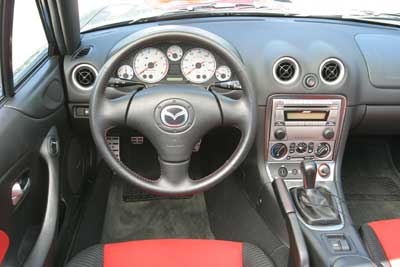Recent Articles
Popular Makes
Body Types
2006 Mazda MX-5 Miata vs. 2004 Mazdaspeed MX-5 Miata Photo Gallery
Six of one, half a dozen of the other
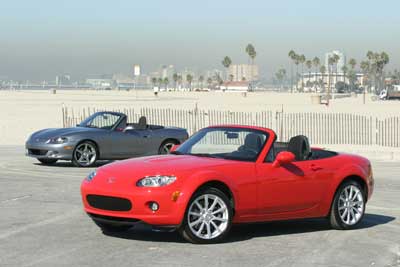
Improving an icon is dicey business. Ask the Coca-Cola Company what happened with that new recipe they tried back in the 1980s, or Jeep how folks felt about square headlights on the 1987-1995 Wrangler. And don’t even get us started on Disney World’s Epcot Center. Facing the challenge of crafting something all-new, yet comfortably old, is daunting at best, and to a large degree Mazda has found success with the redesigned 2006 MX-5 Miata. Loved and cherished by enthusiasts around the globe, the Mazda Miata jump started the modern roadster renaissance when it debuted for the 1990 model year. Its design principle was a simple one: , a Japanese phrase loosely translated to mean horse and rider as one. Weight has always been the Miata’s enemy, and the company has managed to keep its elemental sports car light, lithe, and incredibly responsive for 16 straight years despite increasingly stringent safety and emissions regulations. Those attributes remain intact with the all-new 2006 Mazda MX-5 Miata, a car that represents a dynamic home-run but which breaks little new ground as a sum of its parts. In many ways, the new version is a big improvement over the old car, but in just as many ways, the old car is preferable to the new version. And while I’m not ready to swap my 2004 Mazdaspeed Miata for a new MX-5, I suspect that any future Mazdaspeed edition of this redesigned icon will be quite difficult for any hardcore Miata fan to resist.
Head to Head
The redesigned 2006 Mazda MX-5 Miata Sport sits higher than the previous-generation Mazdaspeed, a necessity to meet new pedestrian crash compatibility rules in Europe. The result is a long, flat hood and bulbous front end that is not nearly as appealing as the low contoured engine lid and rakish fascia on the older Miata.
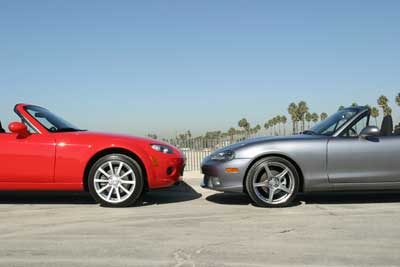
Front Styling
Blending styling cues old and new, the 2006 Mazda MX-5 Miata’s flared front fenders mimic the RX-8 sports car but look out of place on this roadster. Because the hoodline is so tall, the new MX-5’s lights and air inlet are charged with lessening the visual mass of the front fascia. The end result is not as attractive as the previous-generation Miata’s hood bubble, swept fenders, low hoodline, and more aggressive character.
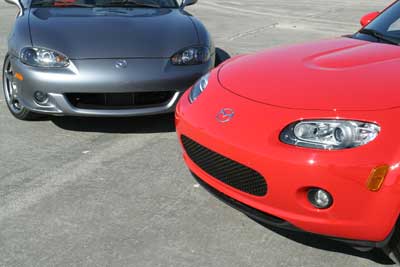
Rear Styling
Mazda has improved the appearance of the Miata’s tail with this redesign. The 2006 Mazda MX-5 Miata’s is tapered and cleaner, decorated with lovely twin exhaust outlets and clear-lens taillights for a modern appearance. In contrast, the old car’s red lamps and single-outlet exhaust are rather tame, and its busy appearance is just annoying.
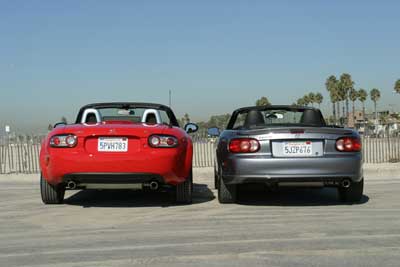
Performance
Rev the new 2006 Mazda MX-5 Miata’s 170-horsepower engine, and you’re rewarded with smooth, seamless, linear power. The car is quick, loves to run to redline, comes equipped with a manual shifter that’s a touch improved over the old model’s already impressive gearbox, and is easier to heel-and-toe downshift. If you can’t shift for yourself, Mazda is offering a slick six-speed automatic with paddle shifters this year. Compared to the old 142-horse motor in the previous-generation Miata, the new MX-5 is much more powerful and refined. It’s even preferable to the peaky 178-horsepower, turbocharged Mazdaspeed MX-5 Miata’s mill despite the blown engine’s lower and higher power and torque peaks. Plus, we got 24.4 mpg with the new engine despite dipping into the throttle on a regular basis, a couple of miles per gallon better than the Mazdaspeed delivers.
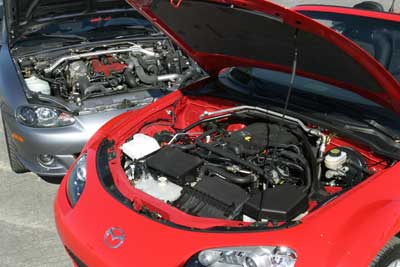
Handling
Always a strong point with Miatas, handling is another of the new 2006 MX-5’s talents. This car is a terrific canyon carver that doesn’t beat occupants up with a rough ride. The new model’s suspension also does a better job of keeping the Miata glued to the road, but the body rolls a little more than the old Mazdaspeed-tuned version and weight sometimes transitions more abruptly than expected. The new electrically-assisted steering quivers and tugs over most pavement irregularities, making the car feel darty and nervous, but surface conditions are clearly transmitted through the wheel to the driver’s fingertips. Like the old Miata, the new MX-5 is equipped with excellent brakes, and the 205/45R17 Michelin Pilot Preceda tires on the 2006 MX-5 squeal less in turns than the Mazdaspeed’s 205/40R17 Toyo Proxes treads despite slightly taller sidewalls. The Mazdaspeed wears lightweight Racing Hart five-spoke wheels with a smoked mirror finish, while the new MX-5 gets gorgeous silver-painted multi-spoke rims.

Trunk Space
Structural rigidity is improved with the 2006 MX-5 Miata, evident when driving over rough pavement or when popping the trunk lid. The old Miata’s trunk is wide but not very deep thanks to the spare donut under the trunk floor. Still, it can swallow a week’s worth of gear for two if you pack carefully. You can even pop the lid and plop a garment bag right into the old Miata, and if your cargo is too big but lightweight, you can always stash it on top of the collapsed roof because there’s a shallow well. The new MX-5’s trunk is slightly larger in terms of total volume, but the opening is much smaller, and the trunk is deeper but not as long. Plus, there’s no spare tire with the new Miata, and since the top forms a semi-tonneau when dropped, you can’t haul that jumbo sized Charmin home from Costco behind the seats.
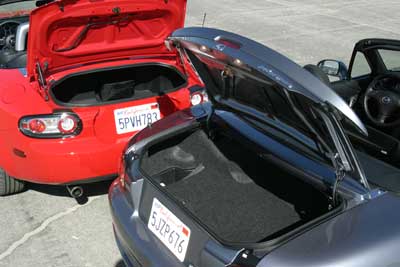
Top Operation
Mazda has been hyping the simplicity of its new top on the 2006 MX-5 Miata, but the reality is that it’s not really easier to use. With the new car, a single header latch must be released, and then the top folds down behind the seats. To secure the top, it must be latched by pushing down on its leading edge. Raising the roof requires that the latch be released using a lever on the bulkhead, and then the driver must reach back over the high rear bulkhead and pull the top up. In the old car, you flip two latches and toss the roof over your head. Sure, it lies in an ugly pile of glass and fabric unless you snap the flimsy tonneau cover on, but so what? Raising it is just as simple. The rear bulkhead on the old car is lower, making it easier to grab the top’s header bar, yank it back over your head, and snap the two latches into place. Wind buffeting is reduced with the new car because the driver sits lower than before, but the old model did a fine job of reducing drafts, too.
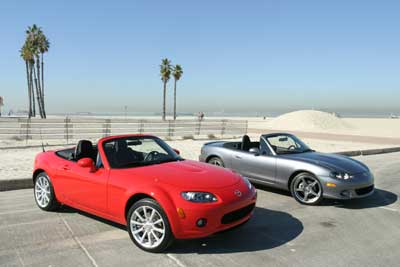
Comfort in 2004
In the old Miata, the relationship between the driver, the dashboard, the windshield, and the sides of the car is preferable to the new MX-5. You feel like you’re sitting up taller with a better view out over a low and lovely hood. The seats also feel wider and better padded, and the upper door panels are covered in a soft material that’s friendly to elbows. Problem spots include a tighter footwell that makes heel-and-toe downshifting more difficult, and a parking brake lever mounted on the driver’s side of the center console where it can rub uncomfortably on the driver’s leg.
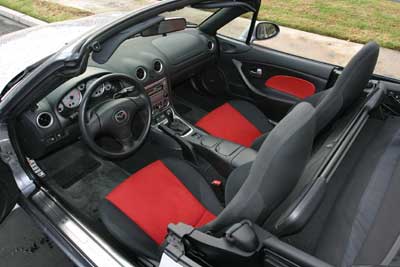
Comfort in 2006
Indeed, the new 2006 MX-5 Miata is larger inside, especially in terms of leg space, but it’s less comfortable than the old car. You sit lower, looking out over a hood that resembles a beveled bell curve – or a first-generation Dodge Durango. The sides of the car are taller than before, the seat bolstering firmer, the fabric on the seats more coarse, the upper door panels constructed using harder materials. Kudos to Mazda for moving the parking brake lever to the passenger’s side of the center console, but the person who designed the door panels ought to be fired. Why Mazda allowed a design that places a hard plastic cupholder right where your left leg braces for high-speed right handers and where your left knee rests during highway cruises is beyond comprehension. It’s almost as though product planners forgot that this is a car for driving, not sipping up to four . Yeah, the new MX-5 has four cupholders. Go figure.
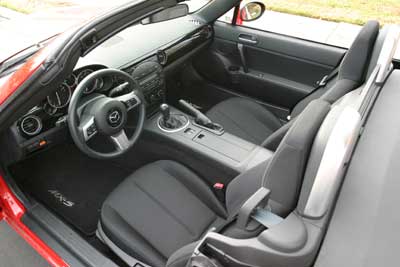
Cockpit in 2004
By 2003, Mazda had succumbed to the trend toward silver plastic, and the 2004 Mazdaspeed Miata has the garish stuff coating the entire center console. The stereo and climate controls are relatively simple, though the temperature, fan and mode dials are located behind the shifter where they’re hard to use. At least the driver has a tachometer, speedo, fuel, temperature, and oil pressure gauges to reference – though that last is little more than an idiot light designed to look like the real deal. Previous-generation Miatas also have shiny hard plastic door grips, but the upper parts of the dashboard and door panels are soft, pliable material.
